(This is the second of a five-part roundtable discussion of Sarah Hall’s How to Paint a Dead Man.)
Other Installments: Part One, Part Three, Part Four, Part Five
More on Hall: “The Early Fiction of Sarah Hall” and a one hour radio interview I conducted with Hall in 2008.
Miracle Jones writes:
“You turned instead to the place where all depraved civilian requests are made and met: the internet.” — Sarah Hall, How to Paint a Dead Man
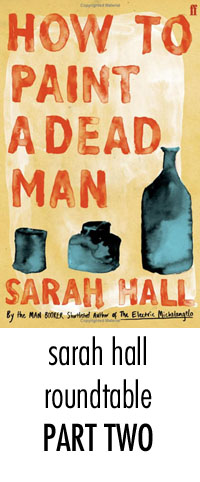 This book was chilly. Cold, cold, cold. Not just cold: frozen. Ordinarily, I distrust books that are so still and moody and arid, but I realized while reading How to Paint a Dead Man that I distrust those books because they don’t freeze anything worth looking at or worth taking the time to get your mind around. Sarah Hall’s novel is frozen solid — your tongue sticks to it — but it is still full of life, like a snow-buried city in the Antarctic or an ice cube stuffed with worms.
This book was chilly. Cold, cold, cold. Not just cold: frozen. Ordinarily, I distrust books that are so still and moody and arid, but I realized while reading How to Paint a Dead Man that I distrust those books because they don’t freeze anything worth looking at or worth taking the time to get your mind around. Sarah Hall’s novel is frozen solid — your tongue sticks to it — but it is still full of life, like a snow-buried city in the Antarctic or an ice cube stuffed with worms.
This book has assembled a whole helluva lot of interesting things — fast things, emotional things, beautiful things, above all ordinary things — and frozen them in time and space so that the artist can paint a truly remarkable still life. The kind of still life painting that gives Peter brief transcendence at the end of the novel, a painting of which he says “was nothing for a moment, and then was everything.”
I certainly couldn’t recommend this book to a casual reader. But that doesn’t mean it isn’t an artistic triumph even as it is not much of a page turner. Instead it is an exercise in shade and light that must have been exceptionally difficult to pull off. This book was far more engrossing than it should have been considering that there is no plot of which to speak. The only events that really “happen” in the book are Peter getting his foot stuck in a hole (which only freezes things further; and how else to freeze this hyperactive madman?) and Annette’s attack by the “Bestia” at the book’s end.
(Who is that “Bestia” by the way? Was I not paying enough attention? I want it to be Ivan or Peter on their Italian trip. I want that to be how Peter “unofficially liberated” the bottle that ends up in Susan’s collection.)
Ed, your question about structure is the most important consideration here. This book is all structure. Form, composition, and relationship. One must analyze this novel the same way one analyzes a serious, labored painting of dusty bottles on a table. The four cycling sections each have a different pronoun perspectives (you, I, she, he), each centering on a main character living in a different decade. Each of the characters are dealing with their own consuming “it,” their muse who is now dead and gone. They each deal with this loss through changing the nature of their art, even as they are physically altered by shifting circumstances.
Susan curates a show of personal effects, Peter conquers mountains (literally and on his canvases), Annette lives through flowers, and Giorgio has his bottles. There is a web of inspiration between the characters that is solidified by Susan’s affair with Tom (and its “fruit”), which ultimately makes a weird, circular nexus. Tom and Susan are clearly breeding the Kwisatz Haderach.
And that’s it. That’s the book. The neat and artistic delivery of a complicated structural form, wrapped in very beautiful language, sentence to sentence. But it is so clever when you consider the limitations! It is so neat and mathematical and attentive! Too convenient? Too contrived? Perhaps. But so what? This is the literary equivalent of “math rock.” If this were an album, it would be by King Crimson. It would be called Bottles.
If you were to make a movie out of How to Paint a Dead Man, how would you do it without contorting the plot into a flashback-riddled caricature? There’s no way. It could be black and white, with only the objects that connect the characters in color: Tom, Peter’s letters, the bottle, and of course all the paintings and sculptures.
I don’t think the Procrustean plot structure is this book’s weak point, however. I think instead the contrived plot elements are what make this book suffer, plot elements that throw into question the “realism” of our Art Squad. I mean, come on, psychic twins? Dude getting his foot stuck in a hole overnight? A noble Fascist painter? A mystic and innocent blind flower girl?
How about a Fascist flower girl? A psychic mountain? A dude getting his foot stuck in blind twins?
But maybe that is the point. The point is the characters each have all of these arbitrary characteristics, and each have none of them. Maybe the point here is the same point as at the end of The Breakfast Club.
Note: Everybody seems to be agreeing about the rough beginning of this book. Perhaps it should have begun at a different place in the cycle. The first chapter sells a much different book than the one you end up reading. That’s why it is so hard to walk across Hall’s “flagstones.” Your mind is trying to synthesize the shifting perspective, unsteady about what is going to happen to “you” next. The second person totally works, but I think it is a mistake to hit the reader with it first thing in this kind of book.
Mark Athitakis writes:
It’s a hell of risk, isn’t it, opening a book in the second person? Like the others who’ve commented, I’m immediately skeptical of any writer who works in that form (call it Bright Lights, Big City Syndrome), because it’s so hard to not look gimmicky and it contrives a false intimacy with the reader. Once I got past that initial irritation, though — and Hall is such an impressive stylist that it didn’t feel like a gimmick — I was free to wonder why Hall used it, and why she introduced us to Susan first.
My general take is that the novel is largely about identity, and how easily we lose our sense of ourselves. And the first chapter is sort of an overture to that them — not only is Susan fractured be cause she’s lost her brother, with who she’s had an unusually symbiotic relationship, but she doesn’t even get the benefit of using “I” in commenting about herself. She’s “you” — meaning the reader, somebody she doesn’t know and can’t access. A line in the second paragraph announces that point pretty clearly: “You can’t quite catch sight of yourself as you go about your life.” I don’t mind being disoriented a little, if the theme of the novel is disorientation.
It’s interesting to jump from Susan’s unsettled state to Giorgio’s exceedingly settled one. The painter is very much the novel’s emotional polestar — he’s dying, but at peace with himself, and the other three characters all seem to be striving for the kind of self-assurance he has, the easy dismissals he can make of others’ attempts to categorize him. It’s important that the journals we read actually exist in the world and aren’t just Hall’s Olympian vision of the great artist’s private mind — those journals are being translated and readied for display in the show that Susan is working on. Susan is capable of reading them, though unless I misremembering she doesn’t actually sit down with them — she’s too consumed by her despair, and the affair that she’s having with the man who’s actually doing the translation.
Regardless, I’m glad there isn’t a concluding moment in the novel where Susan comes across the journals, finds herself thunderstuck by their thoughtful, restful tone, and proceeds to reorder her life. Most novels that break up into multiple narrative voices seem determined to resolve their various threads neatly, but if anything the emotions are more unsettled by the end of the story than they were as the novel opens. One particular element of that which I found interesting (and which I’d be curious to hear others’ thoughts on) is how Peter’s narrative is structured. His story is outwardly dramatic — he’s trapped underneath some rocks, and he’s in a feverish panic to escape — but there’s no real drama to the predicament itself. We know early on that he survives his ordeal. The true drama is in how the incident calls up a time during his youth where his behavior was at its worst. Does Peter’s entrapment expose his true nature (the callous young man perhaps complicit in a drug casualty), or does it strip away his true nature (his happy life as a father and productive, successful artist)? Hall keeps putting her characters into situations where they’re forced to confront those questions. (The author also wants to make some kind of comment on the 60s, I think—why else title Peter’s sections “The Fool on the Hill”?)
That’s enough for the moment, and I haven’t even gotten to Annette and the matter of the Bestia that Frances brings up; I had similiar questions and thoughts on that point, but I’ll defer to others for a bit.
Peggy Nelson writes:
The major theme in the book is a play on the literal translation of still life, nature morte — dead nature. Stillness is like a little death. OK. All the major characters are stilled in certain ways: blindness, grief, old age, hiking, and of course death itself. But the point of still life in art is that from the point of stillness we are supposed to gain greater contemplation, greater insight. We purposely don’t portray the busyness of the world so we can clear our minds and focus on what really matters.
But what really matters here? We have (very) cursory descriptions of the actual art: “mountains,” “bottles,” “photographs,” we are given more detail about Annette’s flower-arranging! (Not that flower-arranging cannot be an art, but Annette does not consider herself an artist, so we can leave that for now.) What really matters in the book are not details of the art, but details of the lives: the actual bottles, the cleaning woman, the exhibit of artist knicknacks, their sex lives. Life means something, because — it begets more of itself? Because it leads to more life (symbolized by the pregnancy at the very end)? Well, isn’t that a little pointlessly circular? If something is meaningful “just because,” then we certainly don’t have to be still to get it. That is not an insight, that is a justification.
And, in this case, it is completely wrong: an artist’s life is more meaningful than their work? No, it isn’t. It is exactly the opposite, for the artist qua artist. Why bother to do anything at all when you can just live? An artist bothers to do anything at all because of the hope (and the promise if achieved), that one’s work will mean more. Here I’ll lapse into the second person as well: if your great insight is that life is more important, you don’t have to become still to realize it. And you don’t have to do art. You have to stay moving, you have to live!
For the first two chapters I was captivated by Hall’s voice and her powers of description. But then it paled fast — not because her voice failed, but because it never changed. There are four major characters in the puzzle living in lightly interconnected but separate worlds, or at least separate enough to give them their own sequence of chapters. Yet the voice in each one sounded exactly the same. The only character that broke out of the beautiful yet somnolent prose was Mauri, Annette’s wild brother (who I thought *may have been the Bestia until I re-read it). For Tolstoy, it is all *happy families that are alike, the unhappy (alienated) ones are supposed to be different – and should have their own voices. Reading this book I was reminded more than once of the brilliance of David Mitchell’s Cloud Atlas, which represents a high note of sequential chapters/different voices. In Hall’s book it’s not different voices/still lives, it’s same voices/still lives, and I think that did the characters a disservice. The similarities are established by all the characters being separated from something essential. But we don’t need the exact same cadence (comma comma comma. declarative. comma comma) to drive the point home; we get it. I wanted to know more about their differences, in that that might illuminate different aspects of alienation.
The coda at the end is from a Renaissance book of painting techniques. It says, literally, that how to paint a dead man is the same as how to paint a living one – you just use different colors. This book was all the same color, the same voice. Someone did not read the manual.
And I want to touch on something in the portrayal of Giorgio, the Italian painter. We meet him as he ruminates on interviewers bugging him about “what it all means.” Why the bottles? Why still life? Why the single focus? He is simultaneously frustrated with the questions, and pities the questioners. Here, spend some more time. Drink coffee and look at the horizon. Stop thinking, pretty much.
Full disclosure: I do “new media” now, but I got my MFA in painting. And one of the major things we struggled with in the studio and the critique sessions was this paradox of expressing the ineffable. Not in our work – we all knew when a piece was successful, even thought the styles were wildly different – but in talking about it. There is the cliche, which this book embraces in Giorgio, of the artist-as-child: can’t talk about the work because doesn’t know how, is not smart enough, art comes from someplace *below the intellect, true artists with true access to this intuitive source are like children, innocent vessels of the spirit, or the flow, or what have you. Now, this idea has old legs, but was really argued as a political trope by Clement Greenberg in promoting the Abstract Expressionists after WWII. Jackson Pollock, the inarticulate vital force! American ingenuity, innocence, and power! See, old verbal Europe, what your decadence got you: Nazis, is what it got you. We’ve cleaned the Aegean Stables with our pure energy, and here it is, expressed in our art. Which of course is necessarily better than yours. That’s when the “center of the art world” shifted to New York from Paris, and of course the money followed.
There is a truth that some things are not verbally accessible; we refer to the ineffable for a reason, there are meanings we can only gesture for, maybe they’re out there, maybe they’re not – and in truly great art we might see them revealed for a moment. Or gestured towards in an intriguing way. But it is a mistake to infer from this that artists are ineffable, that if they can work with images, language is denied them. And that the minute they actually start speaking articulately, they’ve destroyed something in art. Language is not the enemy of visual art, language is the frame. And he who controls the frame, controls the context, and controls the money. As well language gives the artist something to paint about – you do have to think, in words, in order to be interesting. So we were encouraged — no, *commanded, to be verbal advocates on our own behalf, because otherwise someone else would do it for us, and yeah, they might not get it right. Now the character of Giorgio might be old-skool and prefer to leave his frame to the dealers and critics, who apparently have done all right by him and his work. Italian villa plus cleaning woman, anyone? Eat Pray Paint? But for Hall to accept this at face value and treat not only contemporary interpretations of Giorgio’s work via this trope, but to also view the other artists in the book through it, is doing no one any favors, least of all an author who proposes to use language to plumb meaning in visual art.
Abigail Nussbaum writes:
I think I’m the only one so far who took the second person in stride. Not sure why it didn’t throw me at first, but once it became obvious that the different narratives were being told in different persons, my natural tendency to look for patterns and meanings took over, and of course the second person is the perfect voice for Susan, who spent her life completely focused on another person and feels lost and almost disembodied by their death. As Mark notes, Giorgio is the most settled character, the most self-contained. I don’t read him as incapable of analyzing his art so much as humorously uninterested in that analysis unless it taps into the aspects of it that interest him – the technical, which Peter is so in tune with. What Giorgio doesn’t want to analyze is himself, and whether that’s because he’s comfortable in his own skin or unwilling to examine his past, or some combination of the two, the result is the most self-contained character in the novel.
Meanwhile, Peter and Annette are all about the great world outside of them. Peter is the small-town boy who escapes (escapes a life in the dark like his miner father, who left the house before sunrise to go underground) and sees the wide world and joins in its revels, but at the same time there’s a part of himself that he’s kept inaccessible, an aspect that’s been left out of his public image. Annette, meanwhile, wants to be in the world but is kept from it by her mother’s hysterical (though, as it turns out, not at all unfounded) fears. Even so, she ‘sees’ more than anyone gives her credit for (though she doesn’t always understand what she witnesses), and participates in the lives of others.
I thought Frances’s comment about not seeing Peter’s grief for Danny was interesting, because there’s a lot that’s left unsaid or unseen in this novel. Inasmuch as the narratives do connect with each other, they do so around, but not at, the most important moments in the characters’ lives. Susan sees Peter just after Danny’s death. Giorgio receives letters Peter sends him just before he becomes entangled in a poisonous love triangle and an even more poisonous marriage. Annette meets Giorgio just before his illness becomes apparent. Though we learn about the fate of Giorgio’s wife, we never find out why he came under political scrutiny after the war (given that fate, and the fact that he’s eulogized by Annette’s communist teacher, I assume he spoke out against fascism, but that’s not clear) or how that scrutiny affected his career. We have no idea who rapes Annette – Like Peggy, I thought Mauri was the rapist, but it’s later revealed that he was at home at the time, and I don’t think it could have been Peter, because he takes his family to Italy and retrieves Giorgio’s bottle in the mid 80s, more than ten years after Annette’s narrative.
The crux of the characters’ lives is missing. Except for Susan, who arguably doesn’t have a crux to her life, who is the most disconnected of the characters. It is, presumably, no coincidence that Susan isn’t a ‘real’ artist, but seems to have settled in the nebulous region between artist, skilled technician, and critic/curator. There’s almost no discussion of her work as there is of Peter’s, Giorgio’s, or even the watercolors Annette paints at school, and it’s stressed that her connection to Peter has smoothed her way into the British art world even though she’s missing his spark of genius.
In fact, though the second person narrative didn’t bother me, I found Susan’s narrative the least persuasive of the four. It was the way she so quickly demolished her own life in the wake of Danny’s death, and the brisk pace at which she achieved this. It felt like a condensed version of some movie of the week (or a more traditionally structured literary novel) about a person Dealing Badly With Grief. Alienating loved ones, neglecting one’s work, fetishizing some object belonging to or reflecting the dead, having inadvisable, rough sex with someone inappropriate – these are all items on the checklist, and Hall rushes through them much too quickly. The descent into sex clubs and internet porn was so rushed that it couldn’t transcend the cliché.
Not that there’s a shortage of clichés in the novel. Peggy’s comparison to Cloud Atlas is apt but, as she notes, unkind to Hall. Cloud Atlas uses broad clichés and genre tropes as building blocks, and builds something transcendent out of them. How to Paint a Dead Man often seems to bog down in those clichés – the domineering, restrictive Italian mother and her hysteria over her daughter’s sexual purity; the wise old hermit; Peter’s narrative of sexual liberation and drug abuse in the 60s. It’s only because Hall is such a fine and delicate writer that she gets away with these tropes at all (well, that and the fact that she doesn’t linger overmuch on any of them, and that as soon as one begins to grate she switches narratives and into another), but even so I quite often found myself knocked out of the novel by their broadness.

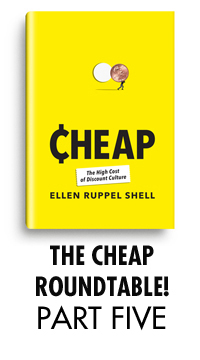
 I thought one of the most stunning aspects of our conversation was how emotional many of us became over a fairly straightforward work of nonfiction. It just goes to prove what I’ve always believed: money is a character in each of our lives. It has a point of view. It reacts to how you treat it. Just like pets and their owners so often look alike, a person’s money is imbued with their persona. When anyone starts talking about how we spend it or how we should spend it, we take it personally.
I thought one of the most stunning aspects of our conversation was how emotional many of us became over a fairly straightforward work of nonfiction. It just goes to prove what I’ve always believed: money is a character in each of our lives. It has a point of view. It reacts to how you treat it. Just like pets and their owners so often look alike, a person’s money is imbued with their persona. When anyone starts talking about how we spend it or how we should spend it, we take it personally. 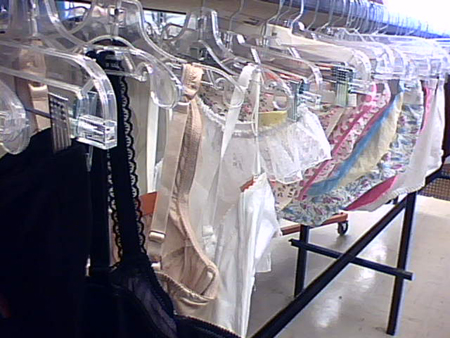
 Finally, about books, I have often considered how Amazon (the devil to many of you!) made book ownership possible. I never bought brand new books before I bought them on Amazon. Feeling like I wasn’t paying full price certainly led me to buy more. So it always confused me when people railed against Amazon on behalf of independent bookstores. Amazon didn’t steal my business. They just created some for itself. And yet truthfully, here I sit with so many books surrounding me, many of them unread, and realize that owning books, especially the number that I do, isn’t something that I need. Maybe this is something that is actually bad…for the environment, for the economy, and for publishing. Giving up book ownership is not something I want to do. It would be a “hard choice” and it’s honestly not one I’m willing to make at the moment.
Finally, about books, I have often considered how Amazon (the devil to many of you!) made book ownership possible. I never bought brand new books before I bought them on Amazon. Feeling like I wasn’t paying full price certainly led me to buy more. So it always confused me when people railed against Amazon on behalf of independent bookstores. Amazon didn’t steal my business. They just created some for itself. And yet truthfully, here I sit with so many books surrounding me, many of them unread, and realize that owning books, especially the number that I do, isn’t something that I need. Maybe this is something that is actually bad…for the environment, for the economy, and for publishing. Giving up book ownership is not something I want to do. It would be a “hard choice” and it’s honestly not one I’m willing to make at the moment. I am humbled and honored to have such a thoughtful panel with which to discuss Cheap‘s vagaries. Thanks to Ed for inviting me. I’ll do my best to keep up with you all.
I am humbled and honored to have such a thoughtful panel with which to discuss Cheap‘s vagaries. Thanks to Ed for inviting me. I’ll do my best to keep up with you all. 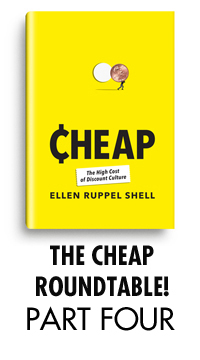
 (This is the fourth of a five-part roundtable discussion of Ellen Ruppel Shell’s Cheap: The High Cost of Discount Culture. Other installments:
(This is the fourth of a five-part roundtable discussion of Ellen Ruppel Shell’s Cheap: The High Cost of Discount Culture. Other installments:  In her endnote, Ruppel Shell points out that Kristof’s been pro-sweatshops since the late 1990s, co-authoring articles titled “Two Cheers for Sweatshops: They’re dirty and dangerous. They’re also a major reason Asia is back on track.” (Rather interesting, this attention-seeking and extremely callous subhead appears
In her endnote, Ruppel Shell points out that Kristof’s been pro-sweatshops since the late 1990s, co-authoring articles titled “Two Cheers for Sweatshops: They’re dirty and dangerous. They’re also a major reason Asia is back on track.” (Rather interesting, this attention-seeking and extremely callous subhead appears  To address Erin’s track suit dilemma, after thinking about this a bit, I’m inclined to agree — particularly in light of Our Man in Boston’s provocative remarks about elites and elitism. But I’m wondering if Ruppel Shell’s stereotypical descriptions are somewhat defensible, because outlet stores, discount stores, and shopping malls are, by way of their respective designs, spaces that prey upon our cognitive abilities to process numerous aesthetics. I don’t want to let Ruppel Shell off the hook on this point — and certainly Janet Maslin didn’t by suggesting that Ruppel Shell needed to “bring a professor of marketing to a Nevada outlet mall to tell her that bargains are phony,” although I think this anti-intellectual assessment isn’t entirely fair to what Ruppel Shell dug up. Much as casinos are specifically designed to keep us gambling (no clocks, no windows, lots of lights, free drinks), I’m wondering if outlet stores might be working in a similar way. Consider
To address Erin’s track suit dilemma, after thinking about this a bit, I’m inclined to agree — particularly in light of Our Man in Boston’s provocative remarks about elites and elitism. But I’m wondering if Ruppel Shell’s stereotypical descriptions are somewhat defensible, because outlet stores, discount stores, and shopping malls are, by way of their respective designs, spaces that prey upon our cognitive abilities to process numerous aesthetics. I don’t want to let Ruppel Shell off the hook on this point — and certainly Janet Maslin didn’t by suggesting that Ruppel Shell needed to “bring a professor of marketing to a Nevada outlet mall to tell her that bargains are phony,” although I think this anti-intellectual assessment isn’t entirely fair to what Ruppel Shell dug up. Much as casinos are specifically designed to keep us gambling (no clocks, no windows, lots of lights, free drinks), I’m wondering if outlet stores might be working in a similar way. Consider  (2) Ed, regarding casinos, the poker chips are a trick as well. Your money has been subtly taken from you from the get go and you’re left with piles of inane plastic disks that go up and down with each spin of the wheel. To me, credit cards are a not-too-distant relative: a thin piece of plastic that magically gets you stuff, stuff stuff!
(2) Ed, regarding casinos, the poker chips are a trick as well. Your money has been subtly taken from you from the get go and you’re left with piles of inane plastic disks that go up and down with each spin of the wheel. To me, credit cards are a not-too-distant relative: a thin piece of plastic that magically gets you stuff, stuff stuff!  I don’t think Cheap is a bad book, and I like Ruppel Shell’s basic mission in making us aware of the choices we make when we shop. But her case against IKEA, like many of the cases presented here, feels underdeveloped. She writes of declining forests and environmental sustainability problems, but this is a problem for all woodworking industries. She ends the chapter by swooning over a heavy (non-IKEA) oak bookshelf, but this bookshelf was also made by cutting down a tree. And even though it will last longer, Ruppel Shell knows there are not enough antique bookshelves around to furnish the world. Sure, if IKEA is committing environmental offenses, then these ought to be addressed and stopped. But Ruppel Shell only hints (and never establishes) that these offenses take place more at IKEA than at any smaller furniture provider. She also shows us that IKEA does try to be environmentally conscious, that they “use every part of the tree”, monitor their suppliers, etc. I see innuendo weaved into these sentences. But I find no clear case, no smoking gun. And Cheap is not a book about the environment or about the problems of an overpopulated world. So the environmental points especially come off as half-baked and incomplete to me.
I don’t think Cheap is a bad book, and I like Ruppel Shell’s basic mission in making us aware of the choices we make when we shop. But her case against IKEA, like many of the cases presented here, feels underdeveloped. She writes of declining forests and environmental sustainability problems, but this is a problem for all woodworking industries. She ends the chapter by swooning over a heavy (non-IKEA) oak bookshelf, but this bookshelf was also made by cutting down a tree. And even though it will last longer, Ruppel Shell knows there are not enough antique bookshelves around to furnish the world. Sure, if IKEA is committing environmental offenses, then these ought to be addressed and stopped. But Ruppel Shell only hints (and never establishes) that these offenses take place more at IKEA than at any smaller furniture provider. She also shows us that IKEA does try to be environmentally conscious, that they “use every part of the tree”, monitor their suppliers, etc. I see innuendo weaved into these sentences. But I find no clear case, no smoking gun. And Cheap is not a book about the environment or about the problems of an overpopulated world. So the environmental points especially come off as half-baked and incomplete to me. 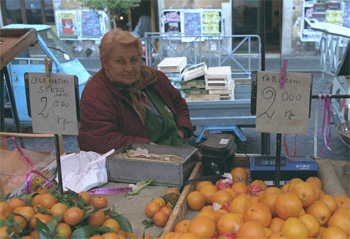 A quick example (and I’m on the side of folks who appreciated Ruppel Shell’s personal anecdotes): There was a Whole Foods located less than a 10 minute walk from my house in Cambridge, Massachusetts. I passed by the store on my walk home from work. It was where I bought my food. I knew it was more expensive, but it was a matter of convenience. Time and money. It was worth it to me to spend the extra bucks to save myself some out-of-the-way trip to a cheaper spot. About three months ago, I moved to Somerville, and the closest supermarket is an expansive, always-crowded Market Basket. It’s got all the same brands as Whole Foods. My first time inside the store, buying the same combo of foods, and more or less the same brands that I would at Whole Foods, I was staggered at how much less it cost. What would’ve been $18 at Whole Foods was a little over $7 at Market Basket. Unbelievable. There is definitely a delight in that. And yet, somewhere in the back of my head, there’s been a gnawing sense that the veggies are saturated with pesticides, that the yogurt is rife with hormones, and that it’s cheaper at Market Basket because the food is poisoned (obviously a little overstated, but you get the idea). And I’ve been sort of wowed about this, in the sense that, holy shit, Whole Foods has done a pretty powerful job marketing themselves. It also speaks to the the complications of price and worth and quality and value that Ruppel Snell explores. Would I rather pay $3.49 for a pint of cherry tomatoes at Whole Foods? Or $2.10 for the same pint at Market Basket? I’d rather pay less, but it does put a doubt — a completely irrational doubt — in my head. Am I getting something that isn’t as good (or, in the case of food, something that isn’t as safe)? Is this doubt borne from the power of Whole Foods’ marketing (and my action buying into it) or the mysteries of price and quality? Or a combo that is hard to know? Whatever it is, it’s certainly interesting to consider.
A quick example (and I’m on the side of folks who appreciated Ruppel Shell’s personal anecdotes): There was a Whole Foods located less than a 10 minute walk from my house in Cambridge, Massachusetts. I passed by the store on my walk home from work. It was where I bought my food. I knew it was more expensive, but it was a matter of convenience. Time and money. It was worth it to me to spend the extra bucks to save myself some out-of-the-way trip to a cheaper spot. About three months ago, I moved to Somerville, and the closest supermarket is an expansive, always-crowded Market Basket. It’s got all the same brands as Whole Foods. My first time inside the store, buying the same combo of foods, and more or less the same brands that I would at Whole Foods, I was staggered at how much less it cost. What would’ve been $18 at Whole Foods was a little over $7 at Market Basket. Unbelievable. There is definitely a delight in that. And yet, somewhere in the back of my head, there’s been a gnawing sense that the veggies are saturated with pesticides, that the yogurt is rife with hormones, and that it’s cheaper at Market Basket because the food is poisoned (obviously a little overstated, but you get the idea). And I’ve been sort of wowed about this, in the sense that, holy shit, Whole Foods has done a pretty powerful job marketing themselves. It also speaks to the the complications of price and worth and quality and value that Ruppel Snell explores. Would I rather pay $3.49 for a pint of cherry tomatoes at Whole Foods? Or $2.10 for the same pint at Market Basket? I’d rather pay less, but it does put a doubt — a completely irrational doubt — in my head. Am I getting something that isn’t as good (or, in the case of food, something that isn’t as safe)? Is this doubt borne from the power of Whole Foods’ marketing (and my action buying into it) or the mysteries of price and quality? Or a combo that is hard to know? Whatever it is, it’s certainly interesting to consider.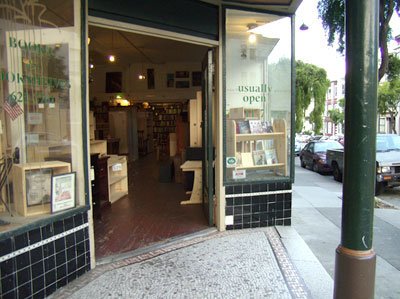 (3) The many problems with IKEA, and it is all thoroughly documented in the “Death of a Craftsman” chapter (and I would suggest consulting the endnotes), is that it represents one of greatest manifestations of discount culture. IKEA’s founder is Ingvar Kamprad. He is the seventh richest man in the world, but he still haggles with vegetable vendors and he still flies coach. IKEA has single-handedly altered Western ideas of interior design, perhaps to the same degree of Postrelian plaudits rightly derided by Jackson. Let me tell you a story. When I moved from San Francisco to Brooklyn, I had to leave behind all of my bookcases. These bookcases were hand-built by a team of craftsmen in the Castro. A place I highly recommend, if you’re ever in the market for bookcases in San Francisco, called
(3) The many problems with IKEA, and it is all thoroughly documented in the “Death of a Craftsman” chapter (and I would suggest consulting the endnotes), is that it represents one of greatest manifestations of discount culture. IKEA’s founder is Ingvar Kamprad. He is the seventh richest man in the world, but he still haggles with vegetable vendors and he still flies coach. IKEA has single-handedly altered Western ideas of interior design, perhaps to the same degree of Postrelian plaudits rightly derided by Jackson. Let me tell you a story. When I moved from San Francisco to Brooklyn, I had to leave behind all of my bookcases. These bookcases were hand-built by a team of craftsmen in the Castro. A place I highly recommend, if you’re ever in the market for bookcases in San Francisco, called  I think that this is a difficult argument to combat within the framework of a growth economy. Companies need to get bigger. Companies need not only profit, but profit that’s greater than the last quarter, and a profit rate that’s continually increasing. Buy more, spend more, acquire more, consolidate more, grow more, more, more. This philosophy of “More” (maybe that’s the next catchy title in this series!) does not align itself well, if at all, with other values — like preserving and maintaining limited resources on the planet — and accommodating, perhaps even promoting, other types of values, such as community, creativity, being loved, and playfulness (with kids or just generally).
I think that this is a difficult argument to combat within the framework of a growth economy. Companies need to get bigger. Companies need not only profit, but profit that’s greater than the last quarter, and a profit rate that’s continually increasing. Buy more, spend more, acquire more, consolidate more, grow more, more, more. This philosophy of “More” (maybe that’s the next catchy title in this series!) does not align itself well, if at all, with other values — like preserving and maintaining limited resources on the planet — and accommodating, perhaps even promoting, other types of values, such as community, creativity, being loved, and playfulness (with kids or just generally).
 I am not quite finished reading Cheap, but I have to admit that I’m finding it more interesting than I expected, seeing that I generally don’t read non-fiction and can’t stand shopping — especially for bargains.
I am not quite finished reading Cheap, but I have to admit that I’m finding it more interesting than I expected, seeing that I generally don’t read non-fiction and can’t stand shopping — especially for bargains.  I only go to Walmart when I need to buy Suave shampoo, Saran wrap, Q-tips (I buy the generic ones) and two or three dozen other really irritating things. I usually put said purchases on my credit card, which I pay off monthly in order to earn the one percent rebates.
I only go to Walmart when I need to buy Suave shampoo, Saran wrap, Q-tips (I buy the generic ones) and two or three dozen other really irritating things. I usually put said purchases on my credit card, which I pay off monthly in order to earn the one percent rebates.  Credit card companies target the poorest, and least credit-savvy, segments of the population to make their money. They do not make money on you if you use the card responsibly and pay in full every month, or if you hold it in reserve only as an emergency fund. They do make money off you if you run it up to the limit and then only pay the minimum, or, better yet, miss payments and run up fees and penalties.
Credit card companies target the poorest, and least credit-savvy, segments of the population to make their money. They do not make money on you if you use the card responsibly and pay in full every month, or if you hold it in reserve only as an emergency fund. They do make money off you if you run it up to the limit and then only pay the minimum, or, better yet, miss payments and run up fees and penalties.  Kudos to Peggy’s “great unasked question” and the subsequent points she raises. Life Inc. sounds like a book I need to visit. But I need to bellyache about the government for a bit anyway. As Ruppel Shell copiously notes in her book, many of us are hard-wired to find a good value or a good price. To that end, I shop at a discount grocer and Walmart. But I also ride pretty far left of center for a reason. I just don’t think that enough people will shop responsibly or self-regulate to make a difference. I try to be conscientious and I try to conserve. Many others do. But it is simply not enough. This is why we need government. I want legislation that supports fair minimum wage. If the best price around is a few cents more in order to pay that wage, I have no problem shelling out $1.25 for my Suave shampoo instead of $0.99. Furthermore, I’m happy to pay taxes that support Medicaid and food assistance. I’d love to see Medicare gradually expanded to relieve the private sector of the choking health care/health insurance behemoth. I’m all for college becoming part of the public school system. I’m for a government that supports effective regulation and inspection of imported food and goods. The list goes on and on. Yes, I know all this means more taxes. I’m okay with that. I am happy to have a little less in order to live in a society that respects and values human dignity. Sorry about the flag-waving, but somewhere along the way, taxation became a dirty word and unfettered capitalism/consumerism became the new golden idol. Call it the bastard child of Ronald Reagan’s trickle-down economics coupling with eight years of Bush’s crazed deregulation.
Kudos to Peggy’s “great unasked question” and the subsequent points she raises. Life Inc. sounds like a book I need to visit. But I need to bellyache about the government for a bit anyway. As Ruppel Shell copiously notes in her book, many of us are hard-wired to find a good value or a good price. To that end, I shop at a discount grocer and Walmart. But I also ride pretty far left of center for a reason. I just don’t think that enough people will shop responsibly or self-regulate to make a difference. I try to be conscientious and I try to conserve. Many others do. But it is simply not enough. This is why we need government. I want legislation that supports fair minimum wage. If the best price around is a few cents more in order to pay that wage, I have no problem shelling out $1.25 for my Suave shampoo instead of $0.99. Furthermore, I’m happy to pay taxes that support Medicaid and food assistance. I’d love to see Medicare gradually expanded to relieve the private sector of the choking health care/health insurance behemoth. I’m all for college becoming part of the public school system. I’m for a government that supports effective regulation and inspection of imported food and goods. The list goes on and on. Yes, I know all this means more taxes. I’m okay with that. I am happy to have a little less in order to live in a society that respects and values human dignity. Sorry about the flag-waving, but somewhere along the way, taxation became a dirty word and unfettered capitalism/consumerism became the new golden idol. Call it the bastard child of Ronald Reagan’s trickle-down economics coupling with eight years of Bush’s crazed deregulation.  To me, that was rather key in the book. It also addresses this “elitism” issue. (That is a word that I think will be a lightning rod for some time due to the election.) Ruppel Shell’s point seems to be that the bargain idea crosses socioeconomic lines. While a bargain for some folks might seem crazy expensive to some (the Whole Foods example), it is still another person’s bargain. But then, as she explains in various ways, the bargains are revealed not to be bargains at all — either in their value to you (they won’t last long or flat out aren’t worth it) or in the true cost to others (or the environment, etc.). Levi is right that, for some items and some people, a cheap price for a short-term purchase may be worthwhile. But as Ruppel Shell shows, there is still the fact that the true price isn’t being exposed to the American consumer. It’s like how some of us are enjoying cheap energy while West Virginia and Kentucky pay with environmental destruction, health problems, etc.
To me, that was rather key in the book. It also addresses this “elitism” issue. (That is a word that I think will be a lightning rod for some time due to the election.) Ruppel Shell’s point seems to be that the bargain idea crosses socioeconomic lines. While a bargain for some folks might seem crazy expensive to some (the Whole Foods example), it is still another person’s bargain. But then, as she explains in various ways, the bargains are revealed not to be bargains at all — either in their value to you (they won’t last long or flat out aren’t worth it) or in the true cost to others (or the environment, etc.). Levi is right that, for some items and some people, a cheap price for a short-term purchase may be worthwhile. But as Ruppel Shell shows, there is still the fact that the true price isn’t being exposed to the American consumer. It’s like how some of us are enjoying cheap energy while West Virginia and Kentucky pay with environmental destruction, health problems, etc.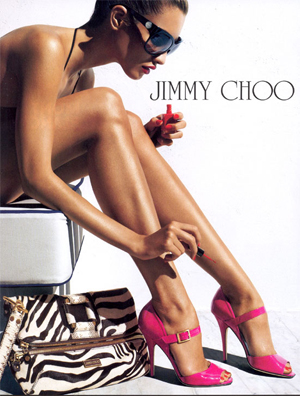 To me, the big unaddressed issue is how we perceive value. Price is not about value. And I don’t think it ever really has been. What determines the price of a Hermes scarf, a Brioni suit, and Jimmy Choo shoes? Workmanship? Quality materials? Or the campaign that convinces some people that $5,000 or $6,000 is okay? Or that $25 or more is the price of a good cigar? (By the way, with workers, farmers at the bottom of the pyramid of production of luxury goods don’t fare better than the those making whatever products end up in Walmart, which, by the way, is no great bargain past a select number of items that are promoted.) And apropos of nothing, Whole Foods is vastly overpriced and oddly managed. (Did you read about the Whole Foods worker who was fired for planning to eat a tuna fish sandwich? Then Whole Foods tried to impede his collection of unemployment comp.) But Whole Foods is apparently well branded. I work part time at a Trader Joe’s and I can declaim on this subject at length if prodded.
To me, the big unaddressed issue is how we perceive value. Price is not about value. And I don’t think it ever really has been. What determines the price of a Hermes scarf, a Brioni suit, and Jimmy Choo shoes? Workmanship? Quality materials? Or the campaign that convinces some people that $5,000 or $6,000 is okay? Or that $25 or more is the price of a good cigar? (By the way, with workers, farmers at the bottom of the pyramid of production of luxury goods don’t fare better than the those making whatever products end up in Walmart, which, by the way, is no great bargain past a select number of items that are promoted.) And apropos of nothing, Whole Foods is vastly overpriced and oddly managed. (Did you read about the Whole Foods worker who was fired for planning to eat a tuna fish sandwich? Then Whole Foods tried to impede his collection of unemployment comp.) But Whole Foods is apparently well branded. I work part time at a Trader Joe’s and I can declaim on this subject at length if prodded.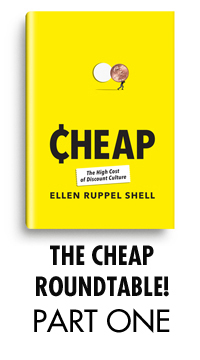
 There’s a bodega that opened up in my neighborhood with a bright and muti-hued awning reading GOURMET DELI. But I’ve examined the goods. The owners are using the same Boar’s Head meat found at nearly every place packing hero sandwiches in the five boroughs. But what this deli has done is undercut the competition. Another deli, situated just one block south, sells a turkey hero for $4.50. About three months ago, this deli had raised its price by a quarter. The regulars still grumble. After all, everything’s going up. Metrocards, milk, beer. But they slide over their four paper George Washingtons and their two copper-nickel George Washingtons. The hero remains a “good deal.”
There’s a bodega that opened up in my neighborhood with a bright and muti-hued awning reading GOURMET DELI. But I’ve examined the goods. The owners are using the same Boar’s Head meat found at nearly every place packing hero sandwiches in the five boroughs. But what this deli has done is undercut the competition. Another deli, situated just one block south, sells a turkey hero for $4.50. About three months ago, this deli had raised its price by a quarter. The regulars still grumble. After all, everything’s going up. Metrocards, milk, beer. But they slide over their four paper George Washingtons and their two copper-nickel George Washingtons. The hero remains a “good deal.”  The great irony with the Ben Franklin quote (which is dredged up in the book when Ruppel Shell mentions Ben & Jerry’s Free Ice Cream Day, which I’ll get to in a minute) is that we’ve become so dependent upon getting the best bang for our buck that all other time-based considerations fall by the wayside. Ruppel Shell brings up the telltale consumer who is willing to drive 75 miles out of their way to an outlet store to buy inferior goods for a cheaper price. She even describes a personal example: a man who drove up 75 miles to check out her car (on sale), noticed a few scratches, and then drove right back home. This is a curious trade-off, running contrary to Franklin’s wisdom. (Then again, we also live in a nation in which our thrifty founding father appears on one of our most expensive dollar bills.)
The great irony with the Ben Franklin quote (which is dredged up in the book when Ruppel Shell mentions Ben & Jerry’s Free Ice Cream Day, which I’ll get to in a minute) is that we’ve become so dependent upon getting the best bang for our buck that all other time-based considerations fall by the wayside. Ruppel Shell brings up the telltale consumer who is willing to drive 75 miles out of their way to an outlet store to buy inferior goods for a cheaper price. She even describes a personal example: a man who drove up 75 miles to check out her car (on sale), noticed a few scratches, and then drove right back home. This is a curious trade-off, running contrary to Franklin’s wisdom. (Then again, we also live in a nation in which our thrifty founding father appears on one of our most expensive dollar bills.)  Before we plunge into Ruppel Shell’s IKEA Billy Bookcase example, which to my mind (and sadly my personal experience), truly reflects a pernicious reliance upon discount culture over quality, I want to first establish whether Ruppel Shell may be inadvertently suggesting that “bargain hunting” might be the new way of wasting time. Does discount culture and consumerism maintain such a hold on American culture that this is now how we spend most of our leisure hours? Should we pin the blame on corporations such as Wal-Mart for injecting capital into small towns and suburbs and establishing a town center? Preexisting local economies may not have been able to do this. Then again, how much of this is illusory? (Ruppel Shell cites a fascinating study from
Before we plunge into Ruppel Shell’s IKEA Billy Bookcase example, which to my mind (and sadly my personal experience), truly reflects a pernicious reliance upon discount culture over quality, I want to first establish whether Ruppel Shell may be inadvertently suggesting that “bargain hunting” might be the new way of wasting time. Does discount culture and consumerism maintain such a hold on American culture that this is now how we spend most of our leisure hours? Should we pin the blame on corporations such as Wal-Mart for injecting capital into small towns and suburbs and establishing a town center? Preexisting local economies may not have been able to do this. Then again, how much of this is illusory? (Ruppel Shell cites a fascinating study from 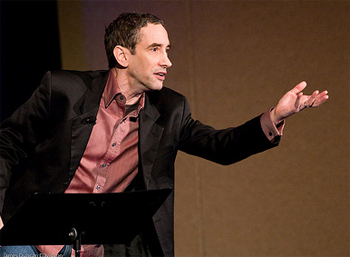 I just finished
I just finished  Personally, I grew up on cheap culture out of necessity. My parents just didn’t have much money and we lived paycheck to paycheck. We couldn’t see the big picture because we couldn’t afford it. Period. But what’s interesting is that, as my parents grew older and could afford to invest in things that would last, neither was able to change their thinking. My mother still struggles to spend more than $15 on a shirt even when she knows that it will likely stretch, fade, etc. She just has certain price points in her head and she just can’t let them go.
Personally, I grew up on cheap culture out of necessity. My parents just didn’t have much money and we lived paycheck to paycheck. We couldn’t see the big picture because we couldn’t afford it. Period. But what’s interesting is that, as my parents grew older and could afford to invest in things that would last, neither was able to change their thinking. My mother still struggles to spend more than $15 on a shirt even when she knows that it will likely stretch, fade, etc. She just has certain price points in her head and she just can’t let them go. As far as your hero sandwich is concerned, Ed, I did feel morally dirty about the frozen shrimp in my freezer after reading Ruppel Shell’s description of the shrimp farms, which is why I found that section so successful. But even here, Ruppel Shell recalls a time when shrimp was a wild and expensive delicacy. There’ a bit of wistful nostalgia in her description. But as she says herself, the good old days weren’t always so good and now wild fish populations are in grave danger al over the globe. Here’s one story to that end
As far as your hero sandwich is concerned, Ed, I did feel morally dirty about the frozen shrimp in my freezer after reading Ruppel Shell’s description of the shrimp farms, which is why I found that section so successful. But even here, Ruppel Shell recalls a time when shrimp was a wild and expensive delicacy. There’ a bit of wistful nostalgia in her description. But as she says herself, the good old days weren’t always so good and now wild fish populations are in grave danger al over the globe. Here’s one story to that end  I remember once having an argument with a friend at an outdoor rock concert on a summer day. I was about to pay $8 for a bottle of Poland Spring water from an amateur price-gouger, and my friend said I was crazy and the price-gouger was unethical. I didn’t see the problem or the ethical violation. The price-gouger had done the work to truck a Styrofoam container of ice and water bottles into our stadium, and that effort certainly seemed to me to be worth an $8 reward.
I remember once having an argument with a friend at an outdoor rock concert on a summer day. I was about to pay $8 for a bottle of Poland Spring water from an amateur price-gouger, and my friend said I was crazy and the price-gouger was unethical. I didn’t see the problem or the ethical violation. The price-gouger had done the work to truck a Styrofoam container of ice and water bottles into our stadium, and that effort certainly seemed to me to be worth an $8 reward.